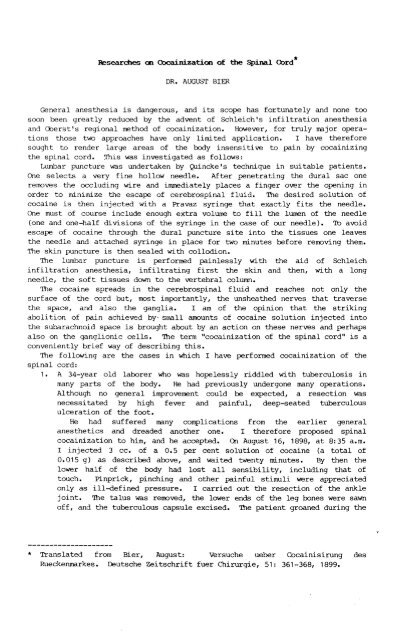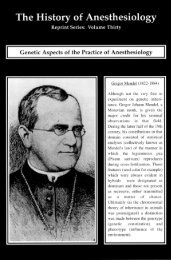Download PDF - Wood Library-Museum of Anesthesiology
Download PDF - Wood Library-Museum of Anesthesiology
Download PDF - Wood Library-Museum of Anesthesiology
You also want an ePaper? Increase the reach of your titles
YUMPU automatically turns print PDFs into web optimized ePapers that Google loves.
Researches on Oocainization <strong>of</strong> the Spinal CordDR. AUGUST BIERGeneral anesthesia is dangerous, and its scope has fortunately and none toosoon been greatly reduced by the advent <strong>of</strong> Schleich's infiltration anesthesiaand Oberst's regional method <strong>of</strong> cocainization. However, for truly major operationsthose two approaches have only limited application. I have thereforesought to render large areas <strong>of</strong> the body insensitive to pain by cocainizingthe spinal cord. This was investigated as follows:Lumbar puncture was undertaken by Quincke's technique in suitable patients.One selects a very fine hollow needle. After penetrating the dural sac oneremoves the occluding wire and immediately places a finger over the opening inorder to minimize the escape <strong>of</strong> cerebrospinal fluid. The desired solution <strong>of</strong>cocaine is then injected with a Pravaz syringe that exactly fits the needle.One must <strong>of</strong> course include enough extra volume to fill the lumen <strong>of</strong> the needle(one and one-half divisions <strong>of</strong> the syringe in the case <strong>of</strong> our needle). To avoidescape <strong>of</strong> cocaine through the dural puncture site into the tissues one leavesthe needle and attached syringe in place for two minutes before removing them.The skin puncture is then sealed with collodion.The lumbar puncture is performed painlessly with the aid <strong>of</strong> Schleichinfiltration anesthesia, infiltrating first the skin and then, with a longneedle, the s<strong>of</strong>t tissues down to the vertebral column.The cocaine spreads in the cerebrospinal fluid and reaches not only thesurface <strong>of</strong> the cord but, most importantly, the unsheathed nerves that traversethe space, and also the ganglia. I am <strong>of</strong> the opinion that the strikingabolition <strong>of</strong> pain achieved by- small amounts <strong>of</strong> cocaine solution injected intothe subarachnoid space is brought about by an action on these nerves and perhapsalso on the ganglionic cells. The term "cocainization <strong>of</strong> the spinal cord" is aconveniently brief way <strong>of</strong> describing this.The following are the cases in which I have performed cocainization <strong>of</strong> thespinal cord:1. A 34-year old laborer who was hopelessly riddled with tuberculosis inmany parts <strong>of</strong> the body. He had previously undergone many operations.Although no general improvement could be expected, a resection wasnecessitated by high fever and painful, deep-seated tuberculousulceration <strong>of</strong> the foot.He had suffered many complications from the earlier generalanesthetics and dreaded another one. I therefore proposed spinalcocainization to him, and he accepted. On August 16, 1898, at 8:35 a.m.I injected 3 cc. <strong>of</strong> a 0.5 per cent solution <strong>of</strong> cocaine (a total <strong>of</strong>0.015 g) as described above, and waited twenty minutes. By then thelower half <strong>of</strong> the body had lost all sensibility, including that <strong>of</strong>touch. Pinprick, pinching and other painful stimuli were appreciatedonly as ill-defined pressure. I carried out the resection <strong>of</strong> the anklejoint. The talus was removed, the lower ends <strong>of</strong> the leg bones were sawn<strong>of</strong>f, and the tuberculous capsule excised. The patient groaned during the* Translated from Bier, August: Versuche ueber Cocainisirung desRueckenmarkes. Deutsche Zeitschrift fuer Chirurgie, 51: 361-368, 1899.
















